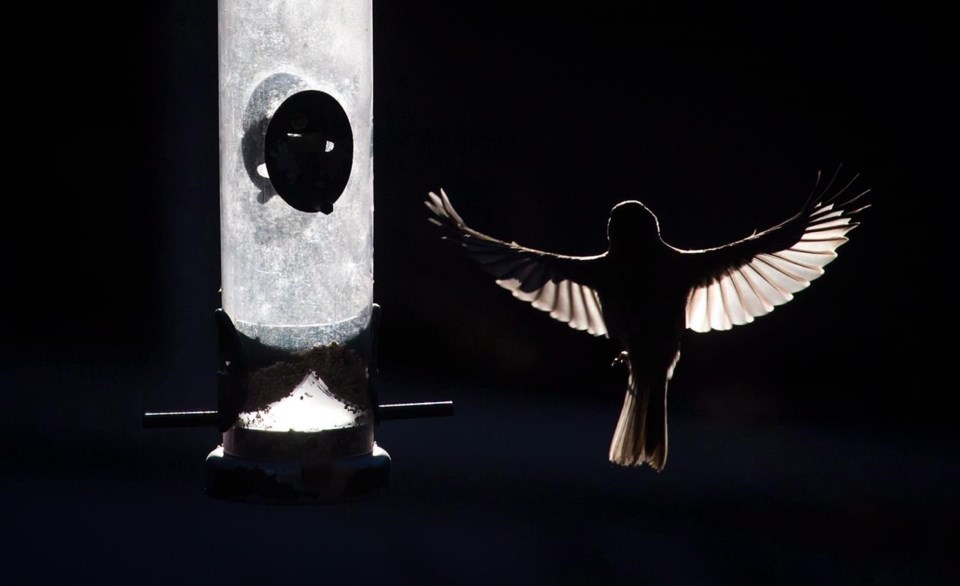HALIFAX — Bird experts in Atlantic Canada are split on whether putting out backyard bird feeders over the winter is harmless or potentially deadly to birds given the risk of avian flu.
Bob Bancroft, the president of Nature Nova Scotia, said in an interview this week that he understands the love many Atlantic Canadians have for birds, but he says in order to protect them from potentially fatal diseases, feeders should not be used.¬Ý
“I feel strongly that if you’re really thinking about the welfare of the birds, there is a big problem with feeding them in the winter,” Bancroft said, noting that salmonella, trichinosis and avian influenza can spread where birds congregate to eat.
The H5N1 avian flu first appeared in Newfoundland last December, when it was confirmed at a farm in the St. John's area. Officials said at the time it was the first detection of the virus in Canada since 2015. It has since been found in wild birds and on dozens of poultry farms across the country, although the Canadian Food Inspection Agency currently lists no facilities in Atlantic Canada as infected.
The Nova Scotia, Prince Edward Island and Newfoundland and Labrador governments have all issued statements over the past year advising residents to avoid feeding birds. Bancroft said the provinces were right to offer this advice, and that New Brunswickers should avoid feeders as well because the risk of transmission exists across the region.
Elizabeth Walsh, a regional biologist with Nova Scotia’s Department of Natural Resources, said in an interview Thursday that the province continues to advise against the use of bird feeders. Walsh said taking down bird feeders is a way for residents to help Nova Scotia’s efforts in “trying to do everything in our power to prevent further spread” of the highly pathogenic H5N1 strain of avian influenza
In Nova Scotia, there have been more than 3,700 dead or sick birds reported to the province this year, and there have been 23 confirmed cases of H5N1 avian influenza, Walsh said. The biologist said she doesn’t know how many of the sick or dead birds have been tested for avian flu — but she noted that diagnosis take time as it requires a PCR test followed by confirmation testing at a laboratory in Winnipeg.
Walsh said the 23 confirmed avian flu cases in Nova Scotia are mostly in seabirds, but they have also been identified in blue jays, crows and pigeons.
Ian Jones, a biology professor with Memorial University in St. John’s, N.L., who focuses on bird conservation, disagrees that bird feeders pose a significant risk of avian flu transmission in Atlantic Canada. He said that because avian flu largely affects waterfowl and poultry, most backyard bird feeders are at an extremely low risk of spreading the disease.
“How are a couple of dark-eyed juncos and chickadees coming to a bird feeder somehow going to be a problem for highly pathogenic avian influenza? And the answer is, scientifically, it’s not,” Jones said in an interview.
“Government’s suggestion to take down bird feeders is scientifically ludicrous,” he said.
Jones said landfills are a much greater risk to avian disease compared to backyard feeders, and if provinces are concerned about wild bird health they should ensure landfills are covered and secured.
“Landfills with uncovered garbage … it's like a giant bird feeder which, I believe, is in effect a giant avian flu super-spreader,” he said. Jones said open landfills attract starlings, crows, gulls and other scavenging birds that can easily transmit diseases.
Vanessa Roy-MacDougall, the executive director of Nature New Brunswick, said that as long as people take good care of their feeders with regular cleaning and monitoring, feeders are OK to use in the winter. Feeders should be scrubbed weekly with either vinegar or a diluted bleach solution, she said.
“The thing to do is keep it clean and keep an eye on the birds in case there is some kind of weird behaviour,” Roy-MacDougall said Wednesday.
If a bird allows you to approach it or is acting lethargic, that could be a sign of avian influenza and would mean the feeder should be removed and the sick bird should be reported to the province.
Fiep de Bie, a Prince Edward Island-based wildlife technician with the Canadian Wildlife Health Cooperative, discourages the use of backyard bird feeders, noting that any risk to birds' health is worth avoiding.
“Avian influenza may not be a big threat at bird feeders, but any place where birds are congregating there is a risk of disease spread,” she said in an interview.
Bancroft suggests that instead of feeders, bird lovers should work on creating an ideal natural environment for birds. He said the best way to do this is by planting any berry or fruit-bearing trees or bushes.
“I planted one high bush cranberry, and birds are all over the place here,” Bancroft said.
This report by The Canadian Press was first published Nov. 5, 2022.
---
This story was produced with the financial assistance of the Meta and Canadian Press News Fellowship.
Lyndsay Armstrong, The Canadian Press
Note to readers: This is a corrected story. A previous version included advice to use a vinegar and bleach solution to clean feeders. The proper advice is to use vinegar or a diluted bleach solution; bleach and vinegar should not be mixed.



